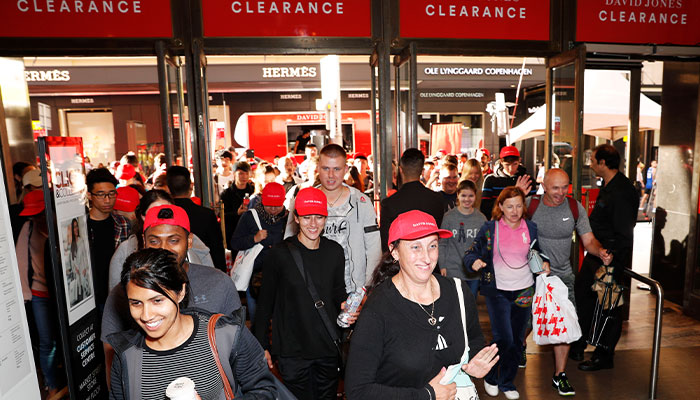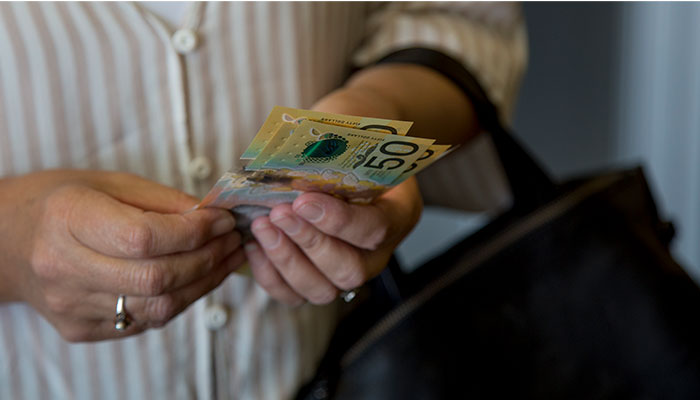We all love a good bargain. When we walk through a shopping mall or open our inbox and see huge red signs labelled ‘75% off', ‘clearance’ and ‘flash sale’, there’s no doubt it can make us reach for our wallets.

'Tis the season: Bargain hunters hit the Boxing Day sales in Sydney but year-round, we are bombarded with shopping deals.
Sales signs work and retailers use them to encourage us to spend. They try to discourage us from doing our price homework, and instead give us a feeling of permission to justify why we’re buying and when we should buy. And as consumers we generally assume the greater the discount, the better the bargain.
But is that always the case?
A research study found that 98 per cent of the discounts (tech, home and personal care products) were cheaper in the six months after big sales events.
Many people see marketing as a form of manipulation, but in fact marketers are just tapping into our psychological vulnerabilities as bargain-hunting consumers.
Consumers can counter these tactics by simply taking a step back and reverse engineering the deals they are being offered.
If you know you are deal-prone, here are steps to take to avoid falling into the trap of fake deals – and instead become a savvy bargain shopper.
Check the anchor price
Consumers mentally ‘frame’ prices according to the highest and lowest prices for a product. We use these ‘pegged’ reference points as a guide for our perceptions of value and to make purchase decisions. The recommended retail price (RRP) sets the main reference point or ‘rack rate’ for the consumer.
But a study in the US found that only 1 in every 500 items sold by department store JCPenney was sold at RRP.
This illustrates how it’s better for consumers to look at the discount depth advertised in sales promotions. ‘Take a further 40 per cent off the lowest ticketed price’ is better value than ‘take 40 per cent of RRP’. The sales price should be noticeably and significantly different from the product’s regular price.
Beware the ‘99’ cent effect
Many stores will be discounting their products in the lead up to Christmas and Boxing Day. They will be changing their price tags to end in .99, and shoppers will continue to fall for this common and extremely effective psychological sales tactic.
Sales prices ending in ’9’ or ‘99’ are perceived as less than prices ending in an even number, referred to as the left-digit effect. It works as a sales tactic because we read from left to right, and so the first digit of the price that we see resonates with us the most, meaning consumers perceive a product priced at $9.99 to be much cheaper than the identical product sold for $10.00 – as irrational as that seems.
'Sale’ doesn’t mean value
A research study looked at prices across a range of major retailers. It found that 98 per cent of the discounts (tech, home and personal care products) were cheaper in the six months after big sales events.

Signs of the time: Retailers are discounting large portions of their stock at any point in time, a study found.
Worse still, 85 per cent of those same products were actually cheaper in the six months prior to the sales event.
We are being constantly bombarded with shopping deals. Another study found that retailers are discounting large portions of their stock. It reported that up to 37 per cent of a retailer’s products are potentially placed on sale at any point in time.
So there is no need to rush in and buy on sale at first glance.
Don’t fall for the ‘nudge’ trick
Retailers use a psychological trick called the nudge unit, in which retailers offer incremental rewards that push consumers towards a goal – whether it be through bonus sign-up offers like instant credit on providing your email, cashback offers for spend, or reward levels (gold, silver, bronze status spend-level membership).
- Breakdancing for equality – and now a spot at the Olympics
- Not so sweet: chocolate, slavery and complicit corporations
These priming techniques signal to consumers that they are on the way toward achieving a bonus or reward and that provides them with extra motivation to keep shopping.
While rewards might be beneficial if the purchases are planned and budgeted for, they can be a trap for shoppers. With one in five purchases now made via Buy Now Pay Later, consumers can easily end up overspending and find themselves laden with debt.
Watch out for FOMO
Be wary of 'was' prices. They are designed to grab attention and create hype but are often based on the original price of products that may now be old and outdated.
This retailing strategy, in which every price drop looks like a saving but is really a false discount, plays on consumer emotions and revolves around creating in our minds a fear of missing out.
FOMO is a bit like the ‘keeping up with the Joneses’ effect and is particularly strong amongst Millennials.
FOMO is the sense of urgency that we experience when looking at a deal and feeling a need to purchase immediately so we don’t miss out. It’s a pervasive anxiety that others might have a more rewarding experience than you.
FOMO is a bit like the ‘keeping up with the Joneses’ effect and is particularly strong amongst Millennials because it’s not just about price; FOMO happens for a range of reasons, one of which relates to the social pressures we experience when we see others consuming. It’s especially prevalent in social media via brand activations, pop-ups and shoppable posts.
This irrational emotional motivation increases consumer vulnerability and promotes a state of psychological, self-regulatory limbo. Consumers feel that if they don’t buy immediately they will have cognitive dissonance afterwards, having missed the deal.
This deal obsession encourages consumers to spend and in the end, the retailers win.
However, there is an important caveat.
Consumers show signs of burnout
Burnout isn’t new. In fact in 2020 it’s almost a permanent feature of life. A recent study found that 75 per cent of us are feeling more burned out than ever before due to ‘pandemic fatigue’– burned out with feelings of anxiety, with juggling the new norms of life, and with worrying about the future of work in a politically and economically turbocharged environment.
Shopping is no different.
But consumers are beginning to feel the psychological pressure of sales burnout. Despite a willingness to spend this year, they are feeling overmarketed-to and are starting to push back.
- Why we need more brazen hussies in Australia today
- How cotton discovery could save the shirts on our backs
A recent study exploring aggressive discounting strategies by online retailers found that consumers are becoming more cynical and discount resistant. They question extreme price claims of deep discounting and are becoming less likely to take them at face value.
This phenomenon is known as discounting of discounts and basically it works like this – the higher the discount, the greater the disbelief. This then has a knock-on effect in that deep discounts counterintuitively reduce discount credibility and reduce purchase intentions.
When discounting crosses the legal line
The Australian Consumer Law requires businesses to conduct honest promotional practices. In any sales strategy retailers need to check that consumers have been given correct information, that the terms of the offer have been communicated clearly, that the overall impression is accurate and that information hasn’t been omitted.
The key issue in assessing whether promotions are likely to mislead or deceive is to consider whether the overall impression the conduct creates in the mind of the customer is false or inaccurate.
The Australian Competition and Consumer Commission issues very clear guidelines about how businesses should conduct their operations. For example, an electronics retailer who advertises a TV indicating that it 'was' $2000 and is 'now' $1500 when the store never sold the TV for $2000, may be construed as engaging in false or misleading conduct.
According to the ACCC ‘businesses are not allowed to make statements that are incorrect or likely to create a false impression’.
Compliance isn’t just about good business. Promotions are critical in managing positive consumer engagement and reputation for the brand.

Dr Jana Bowden (pictured) is Associate Professor in the Department of Marketing at Macquarie Business School.



